Starting out in Acrylics
Welcome back to our series 'Starting out in...' where we give advice about the materials you need to get into a new art form. It is time for Acrylics, a relatively new medium whose versatile use is only exceeded by the abundance of materials available on the market: paints, primers, mediums, varnishes - not to mention the surfaces ranging from canvases to wood panels! Worry not; after reading our beginner's manual, the only thing you will question is, why haven't you started earlier?
[caption id="attachment_713" align="alignleft" width="584"]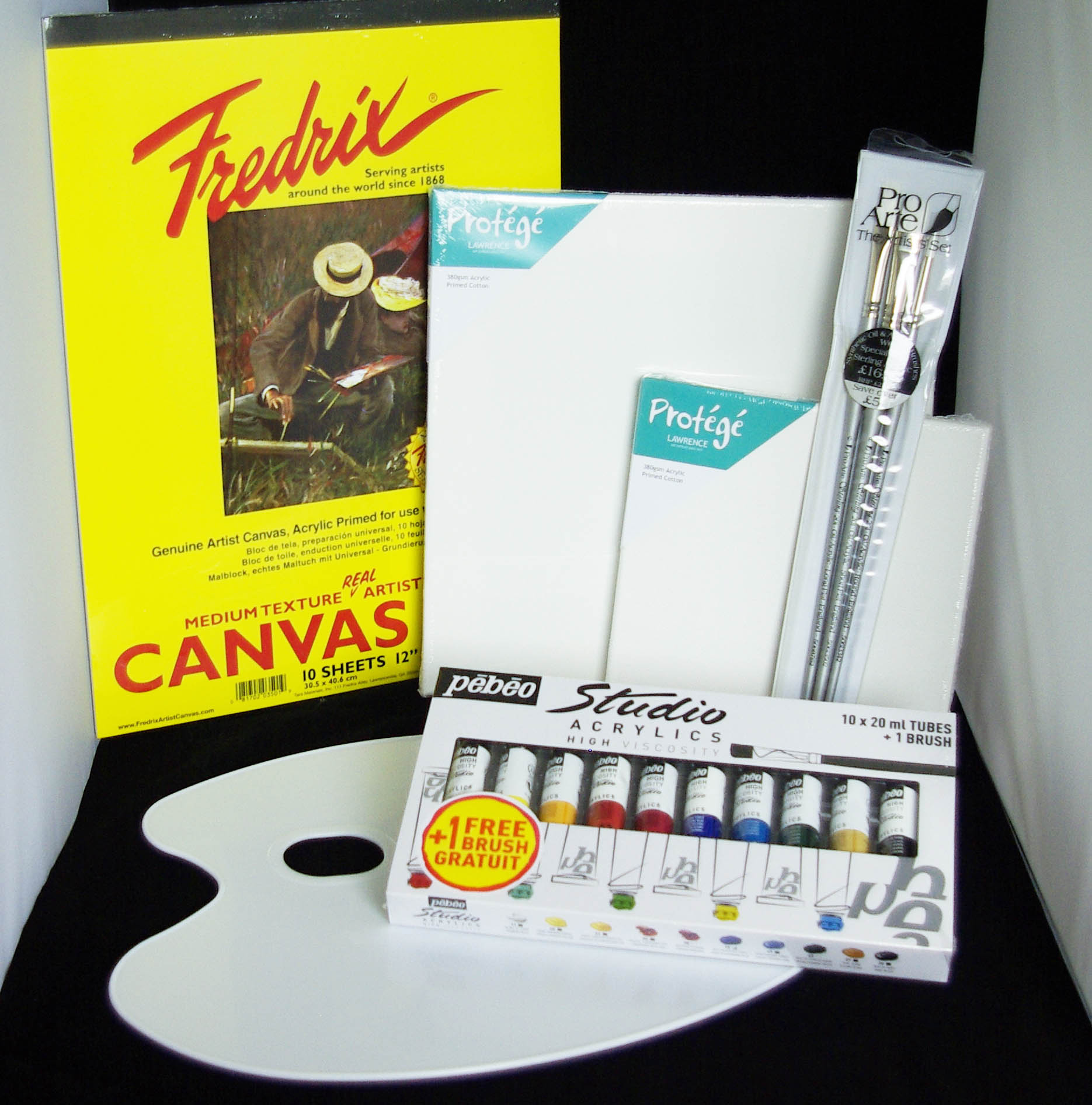 Our starter selection for acrylics: Fredrix Canvas pad, Lawrence Protégé Canvases, Pebeo Studio Acrylic Set of 10, Pro Arte W6 Acrylix Brush Set and a plastic kidney palette[/caption]
Our starter selection for acrylics: Fredrix Canvas pad, Lawrence Protégé Canvases, Pebeo Studio Acrylic Set of 10, Pro Arte W6 Acrylix Brush Set and a plastic kidney palette[/caption]
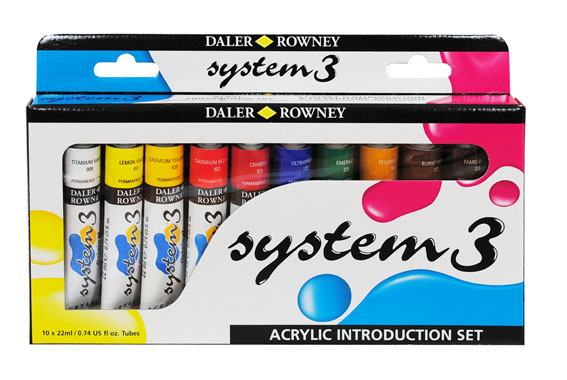 This popular and affordable range comes in more than 50 individual colours and a variety of starter sets. This set of 10 colours include warm and cold versions of yellow and red, a blue, green and orange to reduce time spent with mixing and, of course, a white and a black. Perfect for beginners.
This popular and affordable range comes in more than 50 individual colours and a variety of starter sets. This set of 10 colours include warm and cold versions of yellow and red, a blue, green and orange to reduce time spent with mixing and, of course, a white and a black. Perfect for beginners.
 Pebeo's heavier acrylic paint is perfect for trying different techniques such as impasto work where you paint with a knife (or rough brush strokes) to create texture that stands out. Sets range from 10 to 40! colours on a highly economical price tag and these paints dry to a beautiful satin finish.
Check out our full range of student acrylics here!
Artist quality paints also have a range of benefits. For one, they are formulated with the best available materials and you can always rely on them for their high pigmentation, archival quality and vibrant colours. You will find different consistencies within brands - fluid and heavy bodied acrylics being the most commonly used - and generally more colour options. If you are an experienced painter in another medium (like oils) artist quality acrylics might be the way to go for you. Artist colours use genuine pigment rather than imitation ones and have a greater selection of transparent/opaque colours and matte/satin/gloss finished paint for your different needs.
Here are our top suggestions for artist quality acrylic paint:
Pebeo's heavier acrylic paint is perfect for trying different techniques such as impasto work where you paint with a knife (or rough brush strokes) to create texture that stands out. Sets range from 10 to 40! colours on a highly economical price tag and these paints dry to a beautiful satin finish.
Check out our full range of student acrylics here!
Artist quality paints also have a range of benefits. For one, they are formulated with the best available materials and you can always rely on them for their high pigmentation, archival quality and vibrant colours. You will find different consistencies within brands - fluid and heavy bodied acrylics being the most commonly used - and generally more colour options. If you are an experienced painter in another medium (like oils) artist quality acrylics might be the way to go for you. Artist colours use genuine pigment rather than imitation ones and have a greater selection of transparent/opaque colours and matte/satin/gloss finished paint for your different needs.
Here are our top suggestions for artist quality acrylic paint:
 Beautiful, strong colours and a very high solids content make M Graham's acrylic range a must-try for the acrylic artist. It's creamy but thick and available in 50 radiant colours. M Graham formulated this range to have a slower drying time, allowing the artist to use wet-in-wet techniques and to work with the paint similarly to using oils.
Beautiful, strong colours and a very high solids content make M Graham's acrylic range a must-try for the acrylic artist. It's creamy but thick and available in 50 radiant colours. M Graham formulated this range to have a slower drying time, allowing the artist to use wet-in-wet techniques and to work with the paint similarly to using oils.
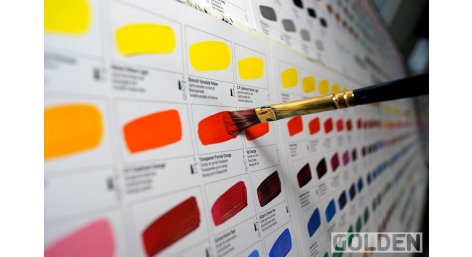 Some call it the best on the market, due to the highest pigment ratio and Golden's method of developing each colour individually. Given their involvement with the history of the medium, it's not at all surprising that their heavy bodied range comes in over 200 regular colours, an iridescent and an interference range. To top it all, Golden has a large range of grounds, mediums and gels that allow you to alter the consistency, texture, finish and drying time of the paint used without sacrificing saturation. While mediums & gels are not a must for beginners, you might want to experiment with them along your journey as they offer very unique results to maximise acrylics' artistic possibilities. Here are just a couple of examples:
[caption id="attachment_679" align="aligncenter" width="568"]
Some call it the best on the market, due to the highest pigment ratio and Golden's method of developing each colour individually. Given their involvement with the history of the medium, it's not at all surprising that their heavy bodied range comes in over 200 regular colours, an iridescent and an interference range. To top it all, Golden has a large range of grounds, mediums and gels that allow you to alter the consistency, texture, finish and drying time of the paint used without sacrificing saturation. While mediums & gels are not a must for beginners, you might want to experiment with them along your journey as they offer very unique results to maximise acrylics' artistic possibilities. Here are just a couple of examples:
[caption id="attachment_679" align="aligncenter" width="568"] From left to right: Golden Extra Heavy Gel, Golden Crackle Gel, Golden Glass Bead Gel[/caption]
Check out our full range of Artist Quality Acrylics here!
From left to right: Golden Extra Heavy Gel, Golden Crackle Gel, Golden Glass Bead Gel[/caption]
Check out our full range of Artist Quality Acrylics here!
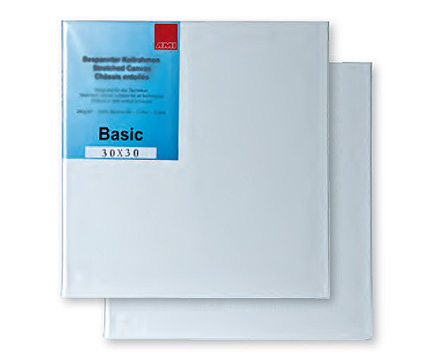 These canvases are the beginner's dream. Highly economical, great quality and comes in 8 different sizes, in square and rectangle shapes and range from the tiny (10 x 20cm) to the moderately large (60 x 80cm). They are also primed so that you can start painting right away.
These canvases are the beginner's dream. Highly economical, great quality and comes in 8 different sizes, in square and rectangle shapes and range from the tiny (10 x 20cm) to the moderately large (60 x 80cm). They are also primed so that you can start painting right away.
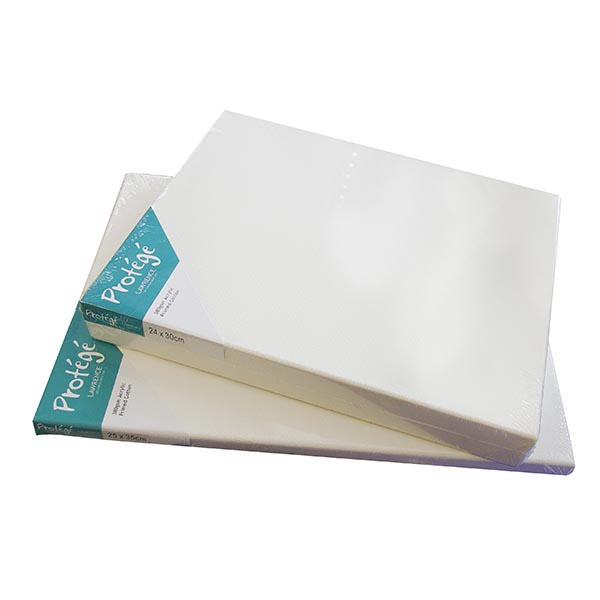 Lawrence Protégé Canvas
This canvas is all the above and more, it has a greater selection of sizes and it's available in two different depths: 1.8 cm and 3.7 cm. Beginners will appreciate that these canvases come in packs of 6 or 8 as well as singularly, which means you can stock up on your preferred practice sizes easily and economically and they will keep you going for a long time!
Lawrence Protégé Canvas
This canvas is all the above and more, it has a greater selection of sizes and it's available in two different depths: 1.8 cm and 3.7 cm. Beginners will appreciate that these canvases come in packs of 6 or 8 as well as singularly, which means you can stock up on your preferred practice sizes easily and economically and they will keep you going for a long time!
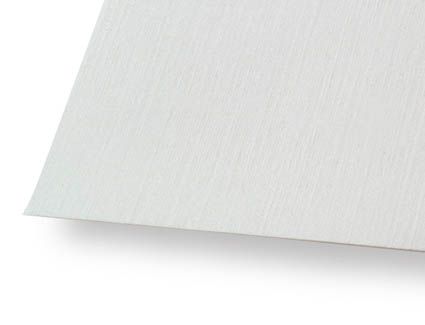 Clairefontaine Oil Paper[/caption]
Acrylic Paper
Generally speaking, you can use any paper, however, heavier watercolour paper (300gsm and up) works better if you are planning to use a lot of water to prevent warping. Hot press gives you a smooth surface, while NOT and Rough watercolour papers have more tooth - which one to choose will depend on the desired effect. There are papers specifically designed for acrylics, like this Clairefontaine Oil paper which has a linen-like texture and is suitable for both oil and acrylic painting.
Check out our full range of Acrylic Papers here.
[caption id="attachment_695" align="alignright" width="200"]
Clairefontaine Oil Paper[/caption]
Acrylic Paper
Generally speaking, you can use any paper, however, heavier watercolour paper (300gsm and up) works better if you are planning to use a lot of water to prevent warping. Hot press gives you a smooth surface, while NOT and Rough watercolour papers have more tooth - which one to choose will depend on the desired effect. There are papers specifically designed for acrylics, like this Clairefontaine Oil paper which has a linen-like texture and is suitable for both oil and acrylic painting.
Check out our full range of Acrylic Papers here.
[caption id="attachment_695" align="alignright" width="200"]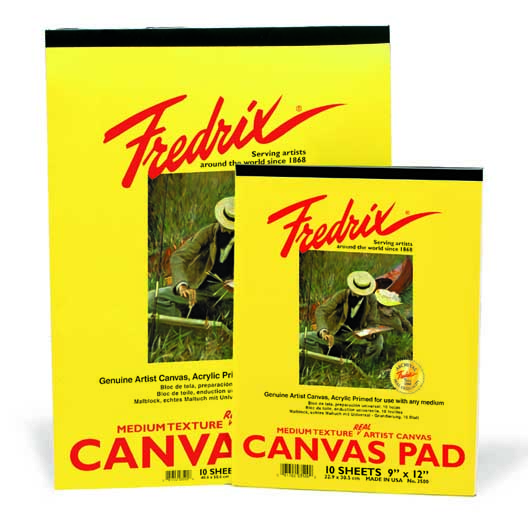 Fredrix Canvas Pads - perfect for beginners[/caption]
Acrylic Pads
When you are trying new media, it is smart to be prepared with a pad, rather than individual sheets of paper, so when you are finished with one piece, you already have the next surface lined up. This Fredrix Canvas pad comes in two sizes, each including 10 sheets of primed canvases.
See our full range of Acrylic Pads here.
Fredrix Canvas Pads - perfect for beginners[/caption]
Acrylic Pads
When you are trying new media, it is smart to be prepared with a pad, rather than individual sheets of paper, so when you are finished with one piece, you already have the next surface lined up. This Fredrix Canvas pad comes in two sizes, each including 10 sheets of primed canvases.
See our full range of Acrylic Pads here.
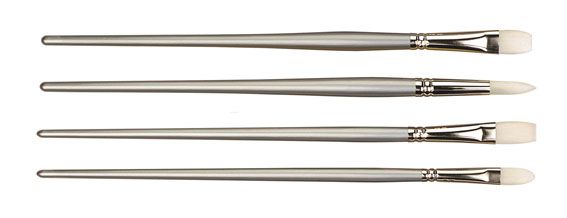 Pro Arte Series 201 - Short Flat, Round, Long Flat and Filbert (top to bottom)[/caption]
Pro Arte Series 201 - Short Flat, Round, Long Flat and Filbert (top to bottom)[/caption]
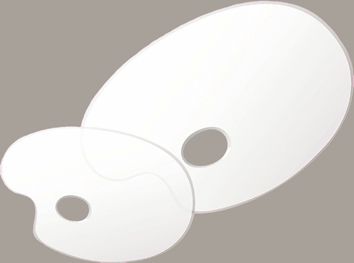 A clear Perspex palette[/caption]
Palettes
A plastic palette with a thumb hole is the acrylic painter's best friend. It is convenient to hold while painting, easy to clean and usually comes in clear or white which helps you mix your colours more accurately.
[caption id="attachment_699" align="alignright" width="193"]
A clear Perspex palette[/caption]
Palettes
A plastic palette with a thumb hole is the acrylic painter's best friend. It is convenient to hold while painting, easy to clean and usually comes in clear or white which helps you mix your colours more accurately.
[caption id="attachment_699" align="alignright" width="193"]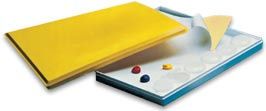 Sta-wet palettes keep paint moist for weeks[/caption]
Sta-wet Palettes
One thing to keep in mind about acrylic paint is that it dries fairly quickly in the open. Once it's dry you won't be able to use any leftover paint so it might be worth considering buying a palette that will keep your acrylic paint moist for weeks. Sta-wet palettes like this are perfect, they keep your paints in a workable condition and you never have to waste any paint either! Have a look at our full range of palettes here!
[caption id="attachment_700" align="alignright" width="157"]
Sta-wet palettes keep paint moist for weeks[/caption]
Sta-wet Palettes
One thing to keep in mind about acrylic paint is that it dries fairly quickly in the open. Once it's dry you won't be able to use any leftover paint so it might be worth considering buying a palette that will keep your acrylic paint moist for weeks. Sta-wet palettes like this are perfect, they keep your paints in a workable condition and you never have to waste any paint either! Have a look at our full range of palettes here!
[caption id="attachment_700" align="alignright" width="157"] Golden Gesso[/caption]
Acrylic Gesso
If you are painting on an unprimed surface, you need to make sure you prime it first so it accepts the paint. Two to three coats of gesso, applied with a brush or a spray, are sufficient to seal your surface, whatever that may be! Paint on artboards, window frames, furniture - the possibilities are endless - which is why you will never get bored with acrylics!
This concludes our entry about acrylics. We hope you get inspired to paint with this fantastic medium and keep an eye out for a post about gels, mediums and grounds for intermediate and advanced level acrylic painting!
All products mentioned in this article are available to order at www.lawrence.co.uk, in our Hove shop or by calling us on 01273 260260 ext.1.
Golden Gesso[/caption]
Acrylic Gesso
If you are painting on an unprimed surface, you need to make sure you prime it first so it accepts the paint. Two to three coats of gesso, applied with a brush or a spray, are sufficient to seal your surface, whatever that may be! Paint on artboards, window frames, furniture - the possibilities are endless - which is why you will never get bored with acrylics!
This concludes our entry about acrylics. We hope you get inspired to paint with this fantastic medium and keep an eye out for a post about gels, mediums and grounds for intermediate and advanced level acrylic painting!
All products mentioned in this article are available to order at www.lawrence.co.uk, in our Hove shop or by calling us on 01273 260260 ext.1.
 Our starter selection for acrylics: Fredrix Canvas pad, Lawrence Protégé Canvases, Pebeo Studio Acrylic Set of 10, Pro Arte W6 Acrylix Brush Set and a plastic kidney palette[/caption]
Our starter selection for acrylics: Fredrix Canvas pad, Lawrence Protégé Canvases, Pebeo Studio Acrylic Set of 10, Pro Arte W6 Acrylix Brush Set and a plastic kidney palette[/caption]
Why use acrylics?
Acrylic paint is a relatively new invention and it only dates back to the 1930s when a German chemical factory started experimenting with synthetic resins. During the mid-40s acrylics were further developed into a solution based paint by Leonard Bocour & Sam Golden - the same Golden whose name Golden Artist Colours bears to date. Acrylic paints were first made available for the public in the 1950s. Today, acrylic is a water-based medium with many uses: it can resemble watercolour when diluted while its heavier version is used similarly to oils. Much to the appreciation of artists who tried oil paints before, acrylics dry faster and become waterproof, allowing them to build up the painting in layers. What's even better, acrylics don't contain any solvents, which makes for an easy clean-up and a safer studio environment. Starting out does not have to be a great investment nor a complicated task. You will simply need some paint, brushes and a surface to paint on. As a beginner, you may start out with a yellow, red, blue, black, white and burnt sienna. Alternatively, include cold and warm versions of the primary colours, a black and a white. The less you start with, the more you will rely on yourself which will help you become an expert in colour mixing in no time! Mediums and varnishes can come later, you will have plenty of time to experiment with them.Student and Artist Quality Paint
Next to decide is if you want student or artist quality materials. While there is the difference in price, both have their advantages. As a beginner, you might feel nervous about 'wasting' artist quality paint for your first endeavours or you might even catch empty canvas syndrome and get discouraged from painting. Student - or sometimes called studio - quality does not have to be a compromise. There are many good brands that offer nicely pigmented paint with an economical price tag, allowing you to pick more colours or a bigger starter set. Here are our top suggestions for student acrylics:Daler Rowney System 3 Original
 This popular and affordable range comes in more than 50 individual colours and a variety of starter sets. This set of 10 colours include warm and cold versions of yellow and red, a blue, green and orange to reduce time spent with mixing and, of course, a white and a black. Perfect for beginners.
This popular and affordable range comes in more than 50 individual colours and a variety of starter sets. This set of 10 colours include warm and cold versions of yellow and red, a blue, green and orange to reduce time spent with mixing and, of course, a white and a black. Perfect for beginners.
 Pebeo's heavier acrylic paint is perfect for trying different techniques such as impasto work where you paint with a knife (or rough brush strokes) to create texture that stands out. Sets range from 10 to 40! colours on a highly economical price tag and these paints dry to a beautiful satin finish.
Check out our full range of student acrylics here!
Artist quality paints also have a range of benefits. For one, they are formulated with the best available materials and you can always rely on them for their high pigmentation, archival quality and vibrant colours. You will find different consistencies within brands - fluid and heavy bodied acrylics being the most commonly used - and generally more colour options. If you are an experienced painter in another medium (like oils) artist quality acrylics might be the way to go for you. Artist colours use genuine pigment rather than imitation ones and have a greater selection of transparent/opaque colours and matte/satin/gloss finished paint for your different needs.
Here are our top suggestions for artist quality acrylic paint:
Pebeo's heavier acrylic paint is perfect for trying different techniques such as impasto work where you paint with a knife (or rough brush strokes) to create texture that stands out. Sets range from 10 to 40! colours on a highly economical price tag and these paints dry to a beautiful satin finish.
Check out our full range of student acrylics here!
Artist quality paints also have a range of benefits. For one, they are formulated with the best available materials and you can always rely on them for their high pigmentation, archival quality and vibrant colours. You will find different consistencies within brands - fluid and heavy bodied acrylics being the most commonly used - and generally more colour options. If you are an experienced painter in another medium (like oils) artist quality acrylics might be the way to go for you. Artist colours use genuine pigment rather than imitation ones and have a greater selection of transparent/opaque colours and matte/satin/gloss finished paint for your different needs.
Here are our top suggestions for artist quality acrylic paint:
 Beautiful, strong colours and a very high solids content make M Graham's acrylic range a must-try for the acrylic artist. It's creamy but thick and available in 50 radiant colours. M Graham formulated this range to have a slower drying time, allowing the artist to use wet-in-wet techniques and to work with the paint similarly to using oils.
Beautiful, strong colours and a very high solids content make M Graham's acrylic range a must-try for the acrylic artist. It's creamy but thick and available in 50 radiant colours. M Graham formulated this range to have a slower drying time, allowing the artist to use wet-in-wet techniques and to work with the paint similarly to using oils.
 Some call it the best on the market, due to the highest pigment ratio and Golden's method of developing each colour individually. Given their involvement with the history of the medium, it's not at all surprising that their heavy bodied range comes in over 200 regular colours, an iridescent and an interference range. To top it all, Golden has a large range of grounds, mediums and gels that allow you to alter the consistency, texture, finish and drying time of the paint used without sacrificing saturation. While mediums & gels are not a must for beginners, you might want to experiment with them along your journey as they offer very unique results to maximise acrylics' artistic possibilities. Here are just a couple of examples:
[caption id="attachment_679" align="aligncenter" width="568"]
Some call it the best on the market, due to the highest pigment ratio and Golden's method of developing each colour individually. Given their involvement with the history of the medium, it's not at all surprising that their heavy bodied range comes in over 200 regular colours, an iridescent and an interference range. To top it all, Golden has a large range of grounds, mediums and gels that allow you to alter the consistency, texture, finish and drying time of the paint used without sacrificing saturation. While mediums & gels are not a must for beginners, you might want to experiment with them along your journey as they offer very unique results to maximise acrylics' artistic possibilities. Here are just a couple of examples:
[caption id="attachment_679" align="aligncenter" width="568"] From left to right: Golden Extra Heavy Gel, Golden Crackle Gel, Golden Glass Bead Gel[/caption]
Check out our full range of Artist Quality Acrylics here!
From left to right: Golden Extra Heavy Gel, Golden Crackle Gel, Golden Glass Bead Gel[/caption]
Check out our full range of Artist Quality Acrylics here!
Surfaces for Acrylics
Perhaps one of the most appealing aspect of painting in acrylics is that you can use them on almost any surface, given that you prime it first, which will make sure the paint adheres to the surface. Canvases are the standard choice of surface for acrylics and most come ready-made, pre-primed and framed.Acrylic Canvases
Basic Stretched Canvas These canvases are the beginner's dream. Highly economical, great quality and comes in 8 different sizes, in square and rectangle shapes and range from the tiny (10 x 20cm) to the moderately large (60 x 80cm). They are also primed so that you can start painting right away.
These canvases are the beginner's dream. Highly economical, great quality and comes in 8 different sizes, in square and rectangle shapes and range from the tiny (10 x 20cm) to the moderately large (60 x 80cm). They are also primed so that you can start painting right away.
 Lawrence Protégé Canvas
This canvas is all the above and more, it has a greater selection of sizes and it's available in two different depths: 1.8 cm and 3.7 cm. Beginners will appreciate that these canvases come in packs of 6 or 8 as well as singularly, which means you can stock up on your preferred practice sizes easily and economically and they will keep you going for a long time!
Lawrence Protégé Canvas
This canvas is all the above and more, it has a greater selection of sizes and it's available in two different depths: 1.8 cm and 3.7 cm. Beginners will appreciate that these canvases come in packs of 6 or 8 as well as singularly, which means you can stock up on your preferred practice sizes easily and economically and they will keep you going for a long time!
Acrylic Paper & Pads
[caption id="attachment_685" align="alignright" width="202"] Clairefontaine Oil Paper[/caption]
Acrylic Paper
Generally speaking, you can use any paper, however, heavier watercolour paper (300gsm and up) works better if you are planning to use a lot of water to prevent warping. Hot press gives you a smooth surface, while NOT and Rough watercolour papers have more tooth - which one to choose will depend on the desired effect. There are papers specifically designed for acrylics, like this Clairefontaine Oil paper which has a linen-like texture and is suitable for both oil and acrylic painting.
Check out our full range of Acrylic Papers here.
[caption id="attachment_695" align="alignright" width="200"]
Clairefontaine Oil Paper[/caption]
Acrylic Paper
Generally speaking, you can use any paper, however, heavier watercolour paper (300gsm and up) works better if you are planning to use a lot of water to prevent warping. Hot press gives you a smooth surface, while NOT and Rough watercolour papers have more tooth - which one to choose will depend on the desired effect. There are papers specifically designed for acrylics, like this Clairefontaine Oil paper which has a linen-like texture and is suitable for both oil and acrylic painting.
Check out our full range of Acrylic Papers here.
[caption id="attachment_695" align="alignright" width="200"] Fredrix Canvas Pads - perfect for beginners[/caption]
Acrylic Pads
When you are trying new media, it is smart to be prepared with a pad, rather than individual sheets of paper, so when you are finished with one piece, you already have the next surface lined up. This Fredrix Canvas pad comes in two sizes, each including 10 sheets of primed canvases.
See our full range of Acrylic Pads here.
Fredrix Canvas Pads - perfect for beginners[/caption]
Acrylic Pads
When you are trying new media, it is smart to be prepared with a pad, rather than individual sheets of paper, so when you are finished with one piece, you already have the next surface lined up. This Fredrix Canvas pad comes in two sizes, each including 10 sheets of primed canvases.
See our full range of Acrylic Pads here.
Acrylic Brushes
Depending on your artistic needs and preference you can choose natural or synthetic brushes. Natural brushes for acrylic tend to be made of hog's hair and are bristle to handle heavy loads of paint. On the other hand, good quality synthetics are a lot more common nowadays. They are soft and springy and they lead to a smoother brush work. For beginners we would recommend the Pro Arte Series 201 range that is specifically designed for acrylics. You can opt for a beginner set like this one. You can also cherry pick your sizes and shapes, in this case consider buying 3-5 different sizes and a mix of flat, round or filbert shapes here. [caption id="attachment_697" align="aligncenter" width="567"] Pro Arte Series 201 - Short Flat, Round, Long Flat and Filbert (top to bottom)[/caption]
Pro Arte Series 201 - Short Flat, Round, Long Flat and Filbert (top to bottom)[/caption]
Acrylic Sundries
[caption id="attachment_698" align="alignright" width="171"] A clear Perspex palette[/caption]
Palettes
A plastic palette with a thumb hole is the acrylic painter's best friend. It is convenient to hold while painting, easy to clean and usually comes in clear or white which helps you mix your colours more accurately.
[caption id="attachment_699" align="alignright" width="193"]
A clear Perspex palette[/caption]
Palettes
A plastic palette with a thumb hole is the acrylic painter's best friend. It is convenient to hold while painting, easy to clean and usually comes in clear or white which helps you mix your colours more accurately.
[caption id="attachment_699" align="alignright" width="193"] Sta-wet palettes keep paint moist for weeks[/caption]
Sta-wet Palettes
One thing to keep in mind about acrylic paint is that it dries fairly quickly in the open. Once it's dry you won't be able to use any leftover paint so it might be worth considering buying a palette that will keep your acrylic paint moist for weeks. Sta-wet palettes like this are perfect, they keep your paints in a workable condition and you never have to waste any paint either! Have a look at our full range of palettes here!
[caption id="attachment_700" align="alignright" width="157"]
Sta-wet palettes keep paint moist for weeks[/caption]
Sta-wet Palettes
One thing to keep in mind about acrylic paint is that it dries fairly quickly in the open. Once it's dry you won't be able to use any leftover paint so it might be worth considering buying a palette that will keep your acrylic paint moist for weeks. Sta-wet palettes like this are perfect, they keep your paints in a workable condition and you never have to waste any paint either! Have a look at our full range of palettes here!
[caption id="attachment_700" align="alignright" width="157"] Golden Gesso[/caption]
Acrylic Gesso
If you are painting on an unprimed surface, you need to make sure you prime it first so it accepts the paint. Two to three coats of gesso, applied with a brush or a spray, are sufficient to seal your surface, whatever that may be! Paint on artboards, window frames, furniture - the possibilities are endless - which is why you will never get bored with acrylics!
This concludes our entry about acrylics. We hope you get inspired to paint with this fantastic medium and keep an eye out for a post about gels, mediums and grounds for intermediate and advanced level acrylic painting!
All products mentioned in this article are available to order at www.lawrence.co.uk, in our Hove shop or by calling us on 01273 260260 ext.1.
Golden Gesso[/caption]
Acrylic Gesso
If you are painting on an unprimed surface, you need to make sure you prime it first so it accepts the paint. Two to three coats of gesso, applied with a brush or a spray, are sufficient to seal your surface, whatever that may be! Paint on artboards, window frames, furniture - the possibilities are endless - which is why you will never get bored with acrylics!
This concludes our entry about acrylics. We hope you get inspired to paint with this fantastic medium and keep an eye out for a post about gels, mediums and grounds for intermediate and advanced level acrylic painting!
All products mentioned in this article are available to order at www.lawrence.co.uk, in our Hove shop or by calling us on 01273 260260 ext.1. 





